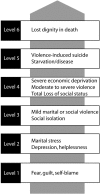Infertility and the provision of infertility medical services in developing countries
- PMID: 18820005
- PMCID: PMC2569858
- DOI: 10.1093/humupd/dmn042
Infertility and the provision of infertility medical services in developing countries
Abstract
Background: Worldwide more than 70 million couples suffer from infertility, the majority being residents of developing countries. Negative consequences of childlessness are experienced to a greater degree in developing countries when compared with Western societies. Bilateral tubal occlusion due to sexually transmitted diseases and pregnancy-related infections is the most common cause of infertility in developing countries, a condition that is potentially treatable with assisted reproductive technologies (ART). New reproductive technologies are either unavailable or very costly in developing countries. This review provides a comprehensive survey of all important papers on the issue of infertility in developing countries.
Methods: Medline, PubMed, Excerpta Medica and EMBASE searches identified relevant papers published between 1978 and 2007 and the keywords used were the combinations of 'affordable, assisted reproduction, ART, developing countries, health services, infertility, IVF, simplified methods, traditional health care'.
Results: The exact prevalence of infertility in developing countries is unknown due to a lack of registration and well-performed studies. On the other hand, the implementation of appropriate infertility treatment is currently not a main goal for most international non-profit organizations. Keystones in the successful implementation of infertility care in low-resource settings include simplification of diagnostic and ART procedures, minimizing the complication rate of interventions, providing training-courses for health-care workers and incorporating infertility treatment into sexual and reproductive health-care programmes.
Conclusions: Although recognizing the importance of education and prevention, we believe that for the reasons of social justice, infertility treatment in developing countries requires greater attention at National and International levels.
Figures


References
-
- Abbas EE. Industry-sponsored research in developing countries. Contemp Clin Trials. 2007;28:677–683. - PubMed
-
- Aboulghar MA. The importance of fertility treatment in the developing world. BJOG. 2005;112:1174–1176. - PubMed
-
- Adeniji RA, Olayemi O, Okunlola MA, Aimakhu CO. Pattern of semen analysis of male partners of infertile couples at the University College Hospital, Ibadan. West Afr J Med. 2003;22:243–245. - PubMed
-
- Adetoro OO, Ebomoyi EW. The prevalence of infertility in a rural Nigerian community. Afr J Med Sci. 1991;20:23–27. - PubMed
Publication types
MeSH terms
LinkOut - more resources
Full Text Sources
Other Literature Sources
Medical

